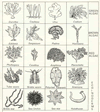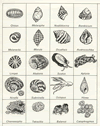Certain habitats of the world have specific major environmental features which are worthy of study so that we can analyse the adaptations of the organisms living there.
Deserts
Deserts cover about a third of the Earth's land area. Cold deserts are
usually found at high altitudes, and hot deserts in subtropical zones,
but both exhibit extremes of temperature and an absence of permanent water.
Insects, reptiles, some birds and small mammals are the most common animals.
Adaptations to prevent water loss include waterproof exteriors, reduced
surface area to minimise evaporation, diurnal activity (dawn and dusk),
burrowing behaviour, efficient kidneys to concentrate urine, ability to
store water (e.g. desert frog), short reproductive life cycle and the
ability to become dormant during dry periods (e.g. brine shrimp).
 Desert plants have adaptations including extensive root systems,
shiny waxy leaf cover, fewer stomata to reduce transpiration (see Plant
systems A: Transport and support), thin spiky leaves to reduce surface
area for water loss and drought resistant seeds.
Desert plants have adaptations including extensive root systems,
shiny waxy leaf cover, fewer stomata to reduce transpiration (see Plant
systems A: Transport and support), thin spiky leaves to reduce surface
area for water loss and drought resistant seeds.
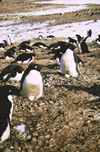
Polar regions
Polar regions are extremely cold with Antarctic winters recording minimum
temperatures of -80°C. Almost no vegetation grows due to the extreme
cold and the six months of darkness in winter, so most food chains are
sea-based. Mammal adaptations for keeping warm include fat layers, thick
fur and winter migration behaviour. Swimming ability is essential to gather
food and travel between ice masses.
Freshwater pond
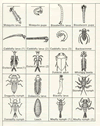 A freshwater pond is a relatively stable habitat with light and water
abundant for plant growth which in turn provides both food and oxygen
for animal life. The water contains dissolved nutrients for plant uptake,
and oxygen in solution is available to all organisms for respiration.
The water temperature remains fairly constant relative to the widely-fluctuating
surrounding air temperature.
A freshwater pond is a relatively stable habitat with light and water
abundant for plant growth which in turn provides both food and oxygen
for animal life. The water contains dissolved nutrients for plant uptake,
and oxygen in solution is available to all organisms for respiration.
The water temperature remains fairly constant relative to the widely-fluctuating
surrounding air temperature.
 The majority of photosynthesis is due to microscopic producers (phytoplankton)
in the water. Other plants are usually present in distinct zones. The
emergent plants of the water's edge give way to free-floating and deep-rooted
plants as well as submerged plants which use the sunlight filtering down
to the bottom. Food chains include microscopic consumers (zooplankton),
small crustaceans, insects (nymphs, larvae as well as adults), small molluscs
(snails and mussels), fish and birds. In the muddy bottom, worms, fungi
and bacteria are found, which decompose the remains of plants and animals.
The majority of photosynthesis is due to microscopic producers (phytoplankton)
in the water. Other plants are usually present in distinct zones. The
emergent plants of the water's edge give way to free-floating and deep-rooted
plants as well as submerged plants which use the sunlight filtering down
to the bottom. Food chains include microscopic consumers (zooplankton),
small crustaceans, insects (nymphs, larvae as well as adults), small molluscs
(snails and mussels), fish and birds. In the muddy bottom, worms, fungi
and bacteria are found, which decompose the remains of plants and animals.
Marine habitats
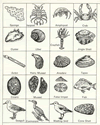 Marine habitats include the open sea (approximately 80% of the world's
surface), tidal estuaries and mangrove swamps, the coastal intertidal
rockpools and the sandy beaches.
Marine habitats include the open sea (approximately 80% of the world's
surface), tidal estuaries and mangrove swamps, the coastal intertidal
rockpools and the sandy beaches.
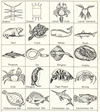 The ocean food chains are based on microscopic plants and animals
(plankton) that drift in the surface waters. Light intensity and temperature
decrease with depth but bottom-dwelling consumers can still survive on
other animals or decomposing matter.
The ocean food chains are based on microscopic plants and animals
(plankton) that drift in the surface waters. Light intensity and temperature
decrease with depth but bottom-dwelling consumers can still survive on
other animals or decomposing matter.
Water provides buoyancy (uplift) supporting the body weight of even the world's largest organisms such as whales, which on land would collapse under their own weight. Due to the great size of the ocean, water temperature fluctuates very little except on the shore line and in rock pools.
 Intertidal rockpools are exposed to the force of breaking waves as
well as daily variations in water availability, temperature and salt concentrations
caused by the movement of the tides. Many animals have adaptations such
as a hard shell and tight muscular foot allowing them to cling tightly
to the rocks preventing dislodgment and drying out. Plants are also often
firmly attached to rocks. Some have a structure called a "holdfast".
Intertidal rockpools are exposed to the force of breaking waves as
well as daily variations in water availability, temperature and salt concentrations
caused by the movement of the tides. Many animals have adaptations such
as a hard shell and tight muscular foot allowing them to cling tightly
to the rocks preventing dislodgment and drying out. Plants are also often
firmly attached to rocks. Some have a structure called a "holdfast".
| Copyright owned by the State of Victoria (Department of Education and Early Childhood Development). Used with Permission. |
